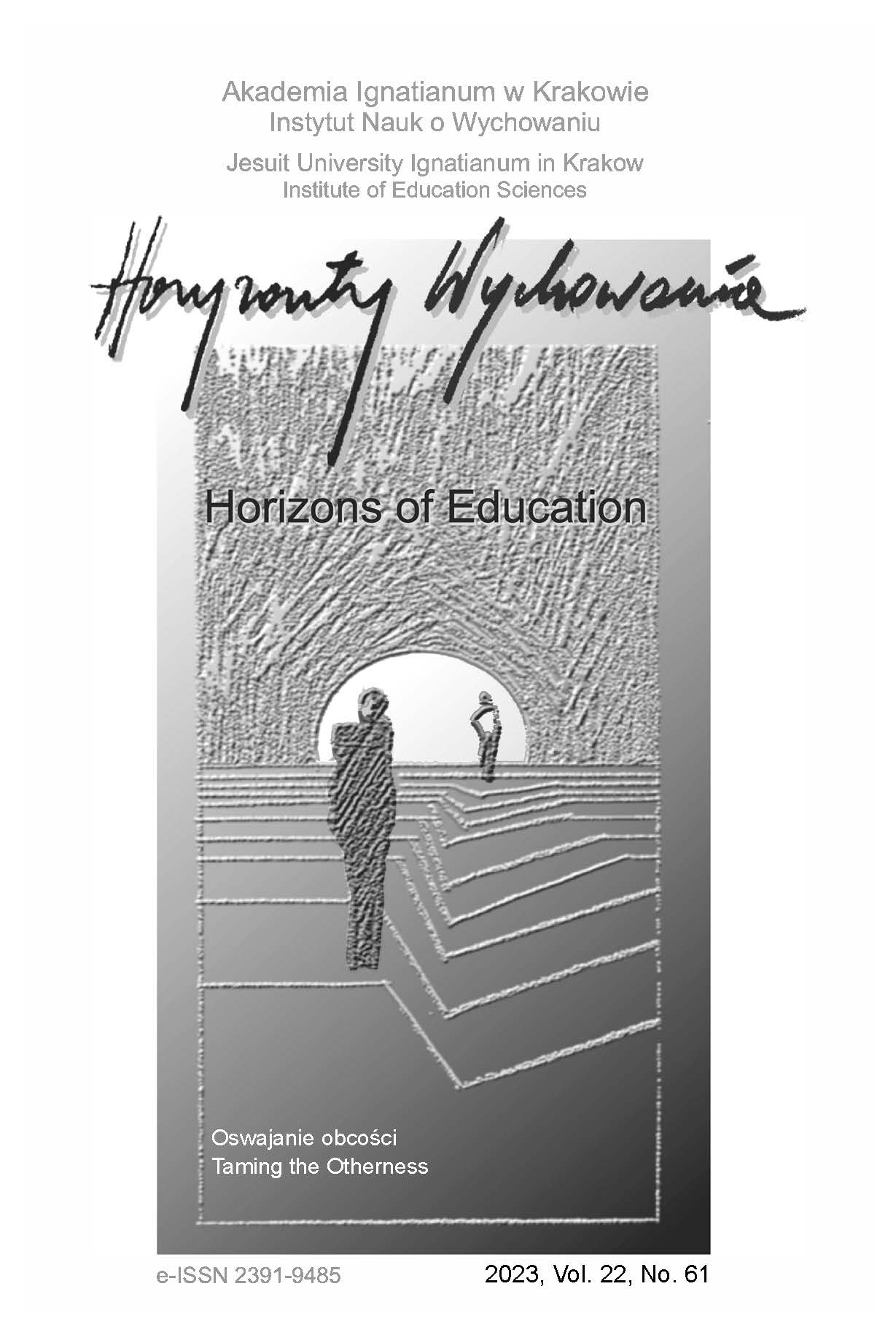The Stranger, The Other or Ours? How Are Foreigners Presented in the Polish Language and Culture Textbook „Po polsku po Polsce”?
Abstract
RESEARCH OBJECTIVE: The article aims at recreating the images of foreigners who appear as protagonists in a contemporary textbook for teaching Polish as a foreign language Po polsku po Polsce. The images are highlighted in the aspect of the protagonists’ experiencing an encounter with Polish culture and recognizing their situation in it in terms of the stranger / the other – ours.
THE RESEARCH PROBLEM AND METHODS: The concept of a cultural gap is adopted as a crite- rion for recognizing the foreigners’ situation understood in terms of the stranger/ the other – ours. The research method is an analysis of the heroes’ statements, which contain information and convey their judgements and, as a result, make it possible to conclude about the occurrence of cultural distance.
THE PROCESS OF ARGUMENTATION: The process of argumentation is subordinated to the presentation of particular aspects of the characters’ image. Subsequently, the following are analyzed: eating habits, ways of spending free time, attitudes towards one’s own ethnic identity, to- wards the Polish language, Polish history and culture.
RESEARCH RESULTS: Foreigners are presented in the textbook in a way that minimizes their initial distance from Polish culture to the possible extreme. They relate to it very positively or even enthusiastically, they identify with it and find themselves in it as ours.
CONCLUSIONS, INNOVATIONS AND RECOMMENDATIONS: Creating a foreign protagonist appearing in a textbook for teaching a foreign language as a person who from the very beginning adapts flawlessly to a new culture does not support students’ efforts to find their own space in it, nor does it support a teacher in developing students’ intercultural sensitivity. The future textbook authors should pay attention to this aspect.
References
Council of Europe. (2003). Europejski system opisu kształcenia językowego: Uczenie się, nauczanie, ocenianie. Wydawnictwa Centralnego Ośrodka Doskonalenia Nauczycieli. https://www.ore.edu.pl/wpcontent/uploads/attachments/ESOKJ_Europejski-System-Opisu.pdf
Dąbrowska, A. (1998). Czy istnieje w podręcznikach języka polskiego dla cudzoziemców obraz Polski i Polaków? (Próba znalezienia stereotypów). W: J. Anusiewicz i J. Bartmiński (red.), Stereotyp jako przedmiot lingwistyki: teoria, metodologia, analizy empiryczne (s. 278-295). Towarzystwo Przyjaciół Polonistyki Wrocławskiej.
Dembińska, K. i Małyska, A. (2013). Start 2. Beginner Polish. Podręcznik do nauki polskiego na poziomie A1. Klub Dialogu.
Dembińska, K. i Małyska, A. (2017a). Start 1. Survival Polish. Podręcznik do nauki polskiego na poziomie A0. B.w.
Dembińska, K. i Małyska, A. (2017b). Start 3. Higher Beginner Polish. Podręcznik do nauki polskiego na poziomie A2. START Kamila Dembińska, Agnieszka Małyska.
Gębal, P.E. (2018). Podstawy dydaktyki języka polskiego jako drugiego. Podejście integracyjno-inkluzyjne. Księgarnia Akademicka.
Gębal, P.E. i Miodunka, W.T. (2020). Dydaktyka i metodyka nauczania języka polskiego jako obcego i drugiego. Wydawnictwo Naukowe PWN.
Golka, M. (2010). Imiona wielokulturowości. Warszawskie Wydawnictwo Literackie MUZA. http://hdl.handle.net/10593/14274
Góralczyk-Mowczan, P. (2015). Porównanie wizerunku polskiej rodziny wyłaniającego się z wybranych podręczników do nauczania języka polskiego jako obcego ze współczesnymi polskimi realiami. W: M. Gaze i P. Góralczyk-Mowczan (red.), Bogactwo językowe i kulturowe Europy w oczach Polaków i cudzoziemców 3 (s. 195-208). Wydawnictwo Uniwersytetu Łódzkiego. http://hdl.handle.net/11089/17719
Nowakowska, M.M. (2013). Polak i Polska w wybranych podręcznikach do nauki języka polskiego jako obcego w konfrontacji z postrzeganiem tychże przez Słoweńców. Acta Universitatis Lodziensis. Kształcenie Polonistyczne Cudzoziemców, 20, 141-147. http://hdl.handle.net/11089/4510
Prizel-Kania, A., Bucko, D., Majcher-Legawiec, U. i Sowa, K. [2016]. Po polsku po Polsce. Pod‑ ręcznik do nauczania języka polskiego jako obcego oraz kultury polskiej dla początkujących. Centrum Języka i Kultury Polskiej w Świecie Uniwersytetu Jagiellońskiego. https://www.popol-skupopolsce.edu.pl/
Sobkowiak, P. (2015). Interkulturowość w edukacji językowej. Wydawnictwo Naukowe UAM.
https:// repozytorium.amu.edu.pl/bitstream/10593/22012/1/Sobkowiak_interkulturowosc_2015_inter- net.pdf
Stankiewicz, K. i Żurek, A. (2010). Obraz Polki/Polaka w serii podręczników do nauczania języka polskiego jako obcego „Hurra!!! Po polsku”. Acta Universitatis Lodziensis. Kształcenie Polonistyczne Cudzoziemców, 17, 495-505. https://dspace.uni.lodz.pl/bitstream/handle/11089/9714/55-stankiewicz.pdf?sequence=1&isAllowed=y
Stempek, I., Stelmach, A., Dawidek, S. i Szymkiewicz, A. (2013). Polski, krok po kroku. Poziom 1. polish courses.com
Stempek, I. i Stelmach, A. (2017). Polski, krok po kroku. Poziom 2. polish-courses.com Strzelecka, A. (2014), Językowy obraz Polaków w podręcznikach „Polski, krok po kroku”. W: M. Gaze i K. Kubacka (red.), Bogactwo językowe i kulturowe Europy w oczach Polaków i cudzoziemców 2 (s. 97-105). Wydawnictwo Uniwersytetu Łódzkiego. https:// dx.doi.org/ 10.18778/7969-123.4.13
Żydek-Bednarczuk, U. (2015). Spotkanie kultur. Komunikacja i edukacja międzykulturowa w glottodydaktyce. Wydawnictwo Uniwersytetu Śląskiego. https://core.ac.uk/download/pdf/197748359.pdf
Copyright (c) 2022 HORIZONS OF EDUCATION

This work is licensed under a Creative Commons Attribution-NoDerivatives 4.0 International License.
Authors who publish in this journal agree to the following terms:
- Authors retain the copyright to their work while granting the journal the right of first publication. The work will be simultaneously licensed under a CC BY-ND license, which permits others to share the work with proper credit given to the author and the original publication in this journal.
- Authors may enter into additional, non-exclusive agreements for the distribution of the published version of the work (e.g., posting it in an institutional repository or publishing it in another journal), provided that the original publication in this journal is acknowledged.
We allow and encourage authors to share their work online (e.g., in institutional repositories or on personal websites) both before and during the submission process, as this can foster beneficial exchanges and lead to earlier and increased citations of the published work. (See The Effect of Open Access). We recommend using any of the following academic networking platforms:





